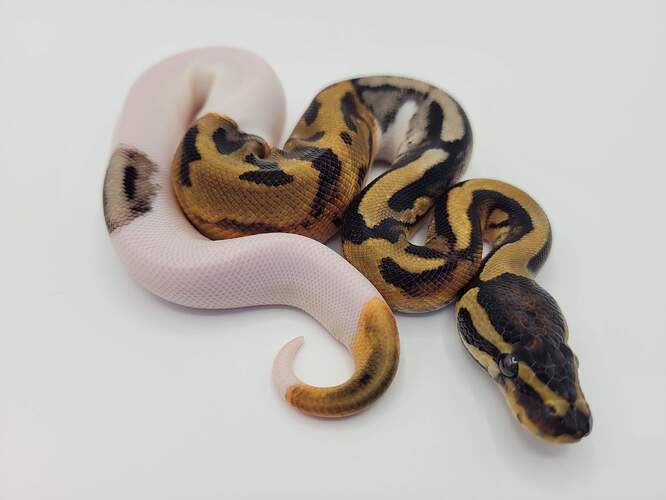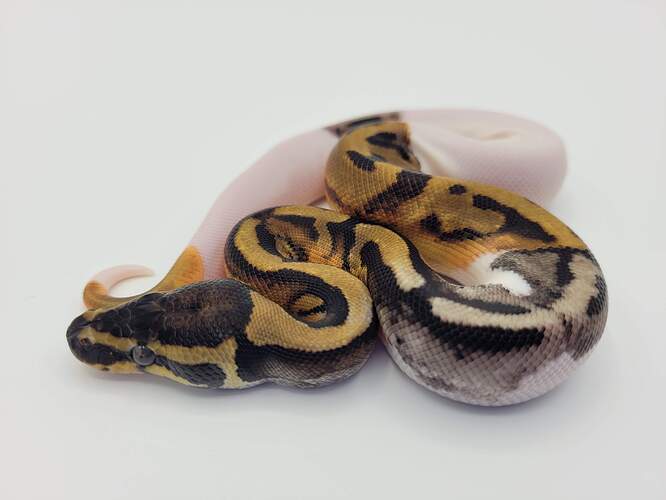As I posted earlier this year, I produced a clutch that contained unexpected Axanthics. It was clutch #23006 and I have a picture of the clutch below.
The pairing was a male Blackhead Enchi Het. Pied X female Pied. Unfortunately, I have no history on the female since the breeder I purchased her from 4+ years ago is no longer in business and didn’t produce her himself anyway. As to the male, his history fairly well known. I bought him from a prominent breeder that produced him and his parents with no know Axanthic anywhere in the breedings. Also, this breeder only works with VPI Axanthic in his projects.
I assumed that my female must have been het for VPI and that my male was het for VPI as well due to a mistake in pairing or something. Well, it seems that wasn’t the case since my genetic test for VPI just came back NEGATIVE.
I will be testing for TSK and GCR as soon as they become available, but this seems like a long shot to me. If you look at the picture, Hatchling #1 is a PARADOX where the Axanthic is showing through. Here are more pictures of him.
My question for anyone who might know is this: Does the fact that I got this paradox support the idea of a spontaneous occurrence of a new line of Axanthic? It’s all very exciting, but perplexing at the same time. To be honest, a positive VPI test would have made things easier for me, but (SRP) Axanthic would be pretty cool too.

Thanks,
Mike McGoveran
Snake River Pythons
11 Likes
Chances are if it wasn’t VPI, probably TSK. But that would be pretty neat if it is new and it’s a project to keep up on for sure. Some good looking babies here.
There’s so many unconfirmed hets floating around that people have either not disclosed 50% hets or just assumed they didn’t pass genes. I think @akmorphs had one prove out as an unconfirmed pied in a pairing?
It’s always a pleasant surprise when it does happen
9 Likes
The paradox is most likely unrelated, just happenstance. As far as I know, usually when you get a spontaneous new morph, there’s only one animal in the clutch that has it, because otherwise you’d need a new gene mutation in multiple offspring to happen at the same time. With BPs being produced at the levels they are, it’s far more likely that both parents had a hidden het.
10 Likes
That makes sense to me.
I’m just trying to think about this from all angles. I was so sure it would it would turn out to be VPI and the negative result really threw me. Just looking at the numbers, if TSK and GCR also come back negative (which I expect) I think it would be fairly safe to assume it’s a new morph.
This was my 3rd clutch from this dam, but first time paired to this male. The male sired 2 other clutches this year, so I have a solid base of animals to work with if this turns out to be a new Axanthic line.
5 Likes
Best of luck on finding out, if it is, you’ll have to let us know!
4 Likes
There’s also MJ and black axanthic….
I seriously doubt it’s a new line of axanthic, becuase the likelihood of two unrelated snakes both developing/carrying a compatible mutation that produces an axanthic phenotype seems slim to none
10 Likes
My suspicion is TSK since MJ and Blk Axanthic are still far less represented than TSK and VPI.
It would be wild though if that was the case and it was something newer like the Blk Axanthic line as a surprise
6 Likes
I agree, it’s probably TSK. But if we were ranking lilkihood of events, I would still place it being MJ line or black axanthic above new spontanious axanthic morph from two unrelated individuals
7 Likes
As others have said, paradox is just that. A paradox. It doesn’t support the spontaneous occurrence of a new line of axanthic.
You would have gotten 1 animal if it was a new line of axanthic, not 2 plus 1 paradox. Multiple animals would not spontaneously create the same mutation at random. The odds of that are so insanely off the charts.
The likelyhood of both parents being some form of het axanthic is the most likely case scenario.
7 Likes
It’s lucky to get the single recessive and the double recessive as well though, since the paradox may not prove out to be able to pass the axanthic on.
5 Likes
A couple of things…
As I understand it, Black Axanthic was first produced in 2008 and GCR in 2010. My female that produced this is 10+ years old and likely more like 15. The male is young. To my mind, this makes both of these much less likely. Also, the Rare Genetics Inc people stated in a recent video that it looks like GCR and MJ might be the same. MJ was also developed in 2008.
TSK (1999) is the only one that makes sense to me.
As far as two unrelated snakes producing a new axanthic phenotype being slim, isn’t that how we got all the others? As I see it anything but VPI and TSK are very long odds. We know it’s not VPI and the breeder that produced the male and both of his parents, doesn’t work with TSK. Odds are long no matter what.
4 Likes
I agree! I was very happy to get hatchlings #2 and #4. I appreciate every one of you that are helping me sort this out. While it would be cool to produce a new morph, if it turns out to be TSK, that sure makes it easier for me to layer in more genes! Win/win I guess.
3 Likes
For you to have had a new mutation, it would’ve shown up in one baby. One baby would’ve had a genetic defect (mutation) that would show this. (As far as I’m aware, I could be wrong) the fact that you produced MULTIPLE babies that are axanthic, leads the scenario to be much much more likely that the parents had unknown hets, from multiple generations that were unknown to them.
For a new phenotype to show up it wouldn’t be a genetic mutation that affects the entire clutch. It would’ve affected one baby. I don’t think new genes just pop up in an entire clutch. It’s usually one singular animal that has something.
6 Likes
Don’t get me wrong, I’d be happy for you if you managed to get a new line out of nowhere. That would be a great thing for you and exciting for the hobby (who doesn’t want more genes/lines, right?) I’m just trying to stay realistic. I understand being hopeful and optimistic, so I’m not trying to crush your dreams here!
7 Likes
I’m sorry, I misunderstood you the first time. I agree with everything you just said.
I thought you were saying it was slim that they both were het for an as yet undiscovered gene. I was trying (and failing lol) to say that both parents being het for an undiscovered morph isn’t necessarily slimmer odds than both randomly being het for the same uncommon morph.
Thanks again for all the input!
EDIT: Just realized it was @chesterhf that made the first statement and not you.
5 Likes
Hopefully the Rare Genetics Inc podcast this week has an update on if MJ and GCR axanthic are the same (and how the monsoon and Spotnose tests are looking and what the heck DGa/b/c are).
If I remember right the MJ line popped up in a piebald project. So maybe test one of the visuals for GCR even if it isn’t as widespread as TSK. Maybe your pieds are related to MJs original stock.
I hatched a similar looking paradox pied with axanthic areas years back. My theory was it might have something to due with axanthic in my pieds but I couldn’t bring myself to inbreed to test. In your case that one could be a chimera with an axanthic sibling. Very interested in hearing your GCR results. Might have to test mine too.
4 Likes
Could be.
With it being a male, I will be pairing him to some 1/2 siblings I have from the other clutches.
2 Likes
The problem with chimeras is you couldn’t be sure which sibling is producing the sperm. I would maybe rat the all over axanthics first.
3 Likes
Of the two that are visual axanthic, one is male (the BH Pied) and one female (Enchi BH Het. Pied). I have at least 6 females I’d like to put the BH Axanthic Pied male to, so I’ll have a female of two available for the paradox. I don’t use an ultrasound, so I max out at 4-6 females per male.
2 Likes



